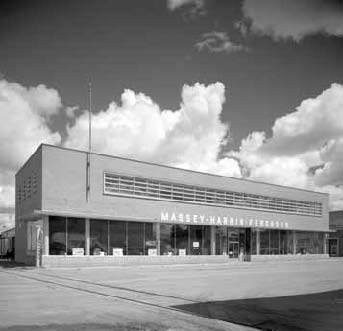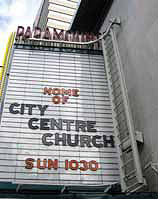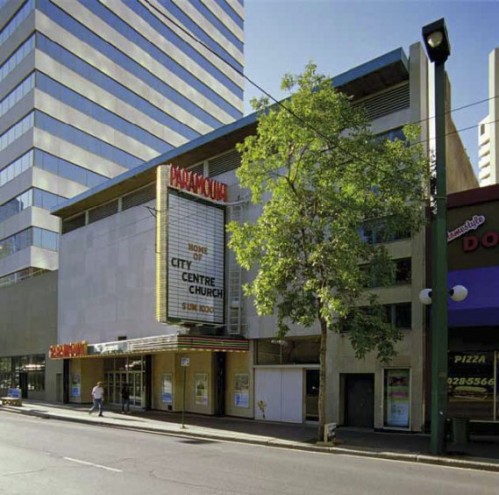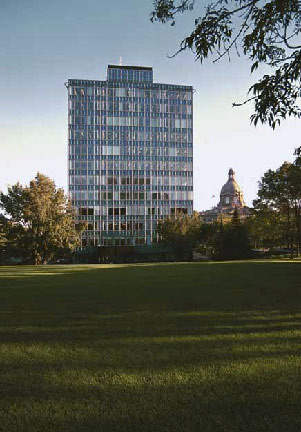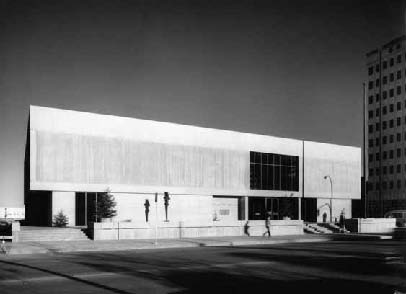ENERGY & INDUSTRY: MAKING EDMONTON MODERN
Shafraaz Kaba
2007
Modernism is a much misunderstood term. It is not about the contemporary, but about a proposal for a universal ideal which began in the late 19th century. Modernism spans the disciplines of architecture, design, fine art, music and literature. It has not been definitively stated, but Victoria and Albert Museum curator Christopher Wilk comes close in his introduction of the catalogue of Modernism, Designing a New World by stating the characteristics of Modernism include. ‘Formal innovation a self-conscious desire to create something new and a tendency towards abstraction.. Modern building was a response to a new world in the late 19th century, where industrialisation was radically changing people’s way of life. Modernism in design and architecture brought ideas of universality, mass production, and a better future by design to a world willing to progress. New materials, technology, methods and processes were changing everything from art to transportation. Modernism hoped to refocus the energy of historicist and neoclassical architecture and design that incorporated much unnecessary embellishment into work that would use new materials and methods to show what was possible in new forms.
MODERNISM AND ARCHITECTURE
Modern architecture was shaped by architects who proposed new ideas and built examples that influenced generations of architects to come. Walter Gropius, Peter Behrens, Le Corbusier, Mies van der Rohe and Frank Lloyd Wright were all architects that significantly changed the course of architecture around the globe at a time when air travel was barely commercially viable. Simple but profound statements such as ‘Less is More. and ‘truth to materials. and ‘form follows function. became ingrained in architectural theory and practice since they were first recited in the early 20th century. The Bauhaus idea of gesamtkunstwerk, or architecture as a ‘total work of art,. was the desired result of building. Advances in concrete and steel construction, the creation of the curtain window wall system and central heating and cooling systems all had an impact on modern architecture. It was the experimentation and adoption of innovative ideas that drove the new forms of modern buildings. Although modernism began in Europe at the turn of the 20th century, the Modern Movement in Edmonton began to take shape in earnest after World War II. The discovery of oil in Leduc in 1947 fuelled an incredible building boom.
The climate of the boom was buoyed by the Space Age and an incredible optimism in man’s technological progress that was only tempered by the Cold War. This era of wealth and sanguinity lead to unprecedented building development that created Edmonton’s finest buildings. New technologies, use of quality materials and construction, as well as design excellence made Edmonton an important and noted leader of modern architecture in Canada from the post-war period to the late 1970s.
DETAIL
There are many telling details of modern architecture. Flat roofs, continuous, strip windows, the rejection of ornament and the expression of structure are hallmarks of modern design. The more subtle details of modern building are found by examining composition, space allocation/programming and use of materials. The Massey-Harris Building (now the Healy Ford dealership) was one of the earliest examples of modern building in Edmonton. The Massey-Harris Company was an international farm implements and equipment company. It became the Massey-Ferguson Company, which is still a recognized leader in farm tractors, combines and other equipment.

The Villa Savoye designed in 1929 in Poissy, France by Le Corbusier was a highly influential modern building (David Murray).
Designed by Edmonton architects Blakey and Blakey and built in 1947, the Massey-Harris Building is significant for its direct reference to the seminal 1929 Villa Savoye designed by Le Corbusier outside Paris. Using the language of the International Style of architecture, the Massey-Harris Building incorporates an asymmetrical composition with a podium-on-columns design. William Blakey was interested in the International style, and experimented with the elements of modern design in several house designs. Blakey brought a refined sense of detail to the Massey-Harris building. Continuous ground floor glazing and long, framed horizontal windows stretching along the second storey take advantage of the building structure being separated from the exterior walls. The podium-on-columns composition was popular at the time because it allowed a completely open ground floor for the display of equipment and vehicles. Office space was located above the main floor showroom. The building is clad in red brick with Tyndall stone trims. A surface-mounted flagpole at the west end completes the asymmetrical composition. Blakey used the techniques and elements of modernism which creates an architecture that would have impressed the founders of the International Style.
The Paramount Theatre by Stanley and Stanley Architects is another building that uses detail to express modern ideas. Opened in 1952, the Paramount Theatre is a sophisticated building that one can appreciate much more after closer examination. A ladder to change the marquee signage was delicately inserted as part of the design. The ladder rolls out on steel channels from the facade to allow easy access to the marquee. The front entry is angled and recessed in order to funnel movie-goers into the lobby. Even the mechanical intake and exhaust grilles were carefully detailed into the facade to read as a linear element just before the exterior wall reaches the rof. The roof juts out slightly over the front facade creating a distinct top to the building. Stanley and Stanley were careful to ensure that architectural details and subtle modern ideas did not get lost in the Paramount Theatre.
INNOVATION
The Alberta Government Telephones or AGT Building (now the Legislature Annex), was probably Edmonton’s most innovative and daring building of the period. Designed by H.W.R. MacMillan of Rule Wynn and Rule, the AGT Building was a bold statement within a stones throw of the Legislature. It was built using concrete poured into wood forms, rather than a structural steel frame due to chronic postwar steel shortages. This building also used poured concrete pilings rather than structural steel for the first time in Alberta. The most remarkable aspect of the AGT Building was the fact that is was the first ‘curtain wall. building in Edmonton. The curtain wall refers to the construction of the exterior steel and glass cladding, which was attached to the structural frame like a ‘curtain.. This structurally independent exterior wall used green Aklo glass, set between plate glass windows made by Pilkington Bros. Shapes & Glass. The AGT building has had its critics since its inception. When it was finished, then Edmonton Mayor Roper referred to it as an “eyesore” and an “architectural monstrosity.” Many people were nostalgic for the neoclassical and revivalist architecture that was typified by the old courthouse, downtown library and post office. The unadorned modern style was something very new to Edmonton’s burgeoning city centre. The pure Early Modern look of the AGT Building is typified by the use of square tower composition, horizontal emphasis in the expression of the floor levels, the use of coloured spandrel glass and integral screens for sun control. The windows did not open on the AGT Building because of the use of a central air handling and air-conditioning system, yet another step forward in modern building and construction.
The oil boom and the optimism of the 1950s may have helped the experimentation, innovation and refinement of architecture. The Northwest Utilities Building (now called the Milner Building) used limestone for the podium form which was elevated above the street with muscular black granite columns. Built in 1959 and designed by Rule Wynn Rule, the Northwest Utilities Building was the first building in Alberta to use Styrofoam insulation, and also featured an automatic sprinkler system, which was still innovative at the time. Its lobby included an optimistic mural depicted Edmonton’s growth from frontier fort into the era of the jetliner. The Northwest Utilities Building was also the first high-rise office tower built in Edmonton after World War II. It remained one of the tallest structures in Edmonton until the end of the 1950s.
Pre-cast concrete was an innovation that Edmonton buildings advanced to great heights. Numerous examples of buildings still exist that used pre-cast panels to grand effect. Concrete industries in Edmonton would have greatly assisted the development of pre-cast use. Precast concrete panels were even proposed for the exterior cladding of the new Edmonton Art Gallery when it was being design in the late 1960s. Victoria Composite High School uses pre-cast concrete panels in structural Ts used as sunshade/overhangs as well as exterior wall spandrel panels that incorporate coloured geometric patterns. Strathearn United Church and St. Stephen’s college use pre-cast concrete in two different ways to provide for sunscreens and shading for windows. The variety of innovative pre-cast concrete use in Edmonton was astounding. The Education Building at the University of Alberta also used exposed aggregate pre-cast panels for the tower.
FINE MATERIALS
Luxurious materials on the facades of post-war public and commercial buildings were relatively common, as there was much pride in these intrepid constructions. Due to the lack of ornament and decoration, Modern design relied upon the beauty and ‘truth in materials. to provide visual delight. Louis Sullivan, who was Frank Lloyd Wright’s mentor, states:
I should say that it would be greatly for our aesthetic good if we should refrain entirely from the use of ornament for a period of years, in order that our thought might concentrate acutely upon the production of buildings well formed and comely in the nude. We should thus perforce eschew many undesirable things and learn by contrast how effective it is to think in a natural, favourous and wholesome way. We shall have learned, however, that ornament is mentally a luxury, not a necessity, for we shall have discerned the limitations as well as the great value of unadorned masses. We have in us romanticism and feel a craving to express it. We feel intuitively that our strong, athletic, and simple forms will carry with natural ease the raiment of which we dream and that our buildings thus clad in a garment of poetic imagery, half hid as it were in choice products of loom and mine, will appeal with redoubled power, like a sonorous melody overlaid with harmonious voices.
Retail stores also made use of exquisite and durable materials. Downtown flagship stores such as S.S. Kresge, Eaton Company and The Hudson’s Bay used materials such as Manitoba Tyndall stone, black granite, terrazzo and custom plated nickel fixtures, all of which would be considered extravagant today.

T. Eaton Department Store, Northwood and Chivers Architects with Blakey & Blakey Architects, 1939 (Edmonton Archives EA-10-1797)
Both the T. Eaton Company and the Hudson’s Bay Company buildings were published in a retrospective on Canadian architecture in the English magazine The Architectural Review in 1942, the only Alberta buildings to be so honoured,. writes Trevor Boddy in Modern Architecture in Alberta. At its temporary relocation to the old Hudson’s Bay Company building, recently re-named Enterprise Square, the Art Gallery of Alberta chose to expose the original terrazzo floor for the galleries, which was hidden by previous insensitive renovations.
Modern form, material expression and detail were naturally expressed in a new building type that emerged in the early to mid-20th century. the movie theatre. When the Garneau Theatre was proposed at the end of the Great Depression in 1938, Famous Players announced that “no expense was to be spared in its exterior cladding or interior appointments.” This triggered a rivalry that created one of the most sophisticated and elegant buildings of the modern era. the previously mentioned Paramount Theatre. With Italian travertine and marble columns, and large planar surfaces of Tyndall stone, the Paramount Theatre was a tour de force of modern design as well as detail. It uses an asymmetrical composition that incorporates the vertical signboard, angled canopy and bold wall surfaces to make an artful statement on Jasper Avenue. The Paramount Theatre has aged gracefully because of the fine materials used in the initial building. It does not scream out for attention in garish colours and oversized forms as some recently built theatres in Edmonton do. It sits elegantly and quietly on Jasper Avenue.

Northern Alberta Jubilee Auditorium exterior and interiors, Alberta Public Works, 1955 (Provincial Archives of Alberta @S194.7, WS142.2, WS142.9)
Although not a movie theatre, the Jubilee Auditorium was a significant new building that proved Edmonton’s coming of age. Announced as a project by Alberta Public Works in 1955 for Alberta’s 50th anniversary as a province, the Jubilee is a fitting gift to the people of Alberta. The Auditorium used Vermont marble on the exterior with Italian marble on the interior that was accented by extensive French walnut paneling within the auditorium, and black walnut elsewhere. The form of the building followed its function and created a magnificent figure on the rather bare landscape of the time. The Jubilee Auditorium became the premiere venue for culture in Edmonton, although it had technical challenges. It also played host to exhibitions and various trade shows that used its extensive lobbies as there was no other facility of its size in Edmonton. Whatever its use, the Jubilee was a remarkable structure for a relatively young province to build in the mid-20th century.
DESIGN EXCELLENCE
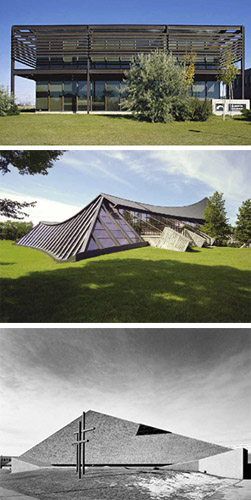
Top to Bottom: Stanley Engineering Building, Peter Hemingway Architect, 1967 (James Dow); Peter Hemingway Leisure & Fitness Centre (formerly Coronation Pool, now named after the architect), 1968 (James Dow); Central Pentecostal Tabernacle, 1972, addition shown by Peter Hemingway Architect (James Dow)
Design excellence in Edmonton Modern architecture is easily demonstrated by the national distinction and press that were awarded to the city’s buildings and architects. Not only were buildings of Edmonton’s modern era built with fine materials and detail, they were pushing the frontier of engineering and design. The Massey Medals, which were Canada’s highest architectural honour, began in 1950 and two Massey Medals were awarded to one Edmonton architect practising in this period. Peter Hemingway received Massey medals for the Stanley Engineering Building (1967) and Coronation Pool (1968). The Massey Medals have now become the Governor General’s Award for Architecture, and continue to recognize the best of Canadian Architecture. The Stanley Engineering Building is a remarkably elegant building using an exterior cor-ten (or weathering) steel frame to provide sunshades for a simple curtain wall office box. Trevor Boddy writes, “Stanley Engineering is a clear and eloquent reference to Eero Saarinen’s rusting cor-ten steel John Deere Building in Moline, Illinois. The detailing… has an almost Japanese quality of quiet refinement.” In examining the drawings of the Stanley Engineering Building, one can see that it is successful due to its scale, proportion and refined detail.
The Coronation Pool (now re-named the Peter Hemingway Fitness and Leisure Centre) is almost opposite in design thinking to the Stanley Engineering Building. Using a highly expressive tensile structure with concrete and wood, the Coronation Pool is a marvel of engineering and design from a period that did not have the benefit of computer aided drawings. These two buildings exemplify the design excellence of Modern architecture in Edmonton. Tribute is also due to the contractor who seemed to take great care in the buildings’ construction. Hemingway’s Massey Medal winning buildings show there was both private and public support for great architecture.
LAMENT
Edmonton is once again in the midst of an oil-and-gas inspired building boom. Unfortunately, the ideals of Modernism and the desire to build with attention to detail, quality materials, innovation and design excellence have been subverted by a rush to profits and return on investment. Most Modern buildings were barely a generation old in 1987 when Trevor Boddy warned his readers of the dangers of neglecting this built heritage. “Seldom has a city so wantonly sold off its architectural heritage to the highest bidder as Edmonton did and continues to do,” says Boddy, “Alberta now faces a serious problem with respect to the preservation of its Modern architectural resources. We must shake the idea that history, as represented by the shells of buildings, ends in Alberta about 1925.” The recent demolition of the Central Pentecostal Tabernacle (another Peter Hemingway/John Laubenthal design) fulfills Boddy’s prophecy written twenty years ago. It is unclear whether a serious effort to find a use for this obsolete building was undertaken. It is obvious the City of Edmonton had no political or administrative will to save an important piece of architectural culture. More recently, architecture critic Christopher Hume wrote in the Toronto Star about his experience in Toronto on March 6, 2005, “Before a building has a chance to grow old, we tear it down to make way for something else that will also be destroyed before its time. once a building hits, say, 75 or 80 years old, it becomes venerable and is deemed untouchable protected by vigilant preservationists. But between its 40th and 70th year, it is at its most vulnerable.”
Part of the reason that modern buildings are difficult to retain is that they were not perfect. Many modern buildings were leaky, drafty and cold. The thin roof lines desired by architects lead to lack of sufficient insulation. Exposed structural slabs and columns created thermal bridges, causing great consumption of energy in the heating of buildings. With the desire to innovate and trail blaze with new methods and materials, many technologies were not proven and failed. If buildings can not perform to the standards demanded of their occupants, they risk being lost. The Edmonton Art Gallery is a prime example of this issue. A building that cannot regulate temperature and humidity to museum standards cannot survive as an art gallery.
The building world is much more complex today. Many different types of wall and roof assemblies are available and with proper detailing and inspections during construction, create good building envelopes. Liability for design failure is also contributing to the conservative nature of contemporary buildings. Few would risk liability on unproven technologies today, particularly in Edmonton’s winter climate. Vancouver’s ‘Leaky Condo. crisis has instilled the fear of armies of lawyers in architects. Public institutions have developed standards and design guidelines for architects to follow so poorly performing buildings are avoided, but come at the cost of prosaic design. But where is there room for experimentation. Can there be design excellence without risk and imagination?
Modern design can still provide inspiration and direction for contemporary architecture. Climate and region specific architecture is emerging to make buildings better tailored to their environment. Modern ideals of universality and affordability are still worth striving for in today’s architecture.
Without a perspective on the past, particularly with our Modern legacy, it is difficult to strive for an improved future. We must protect our valuable architectural heritage, examine its merits and failures, and make better work of architecture today. Without our modern heritage to draw upon, we are forfeiting part of our valuable history.

